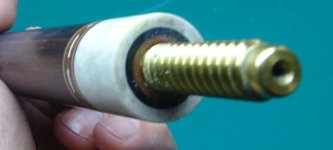JC
Coos Cues
I know this has been discussed but I am having trouble searching for this topic. I'm talking about self centering type pins with a machined barrel. But maybe other types too.
It seems to me that with a properly machined joint hole where the pin fits tight and straight dry that medium super glue should do the job with less fuss and muss than epoxy. A properly machined hole and shaft threads will darn near hold the pin with no glue.
I glued one in a rehab cue with CA yesterday to see how it went. I liked the lack of glue continuing to bubble up at the base. I spun it after seating it and it had about .0015 runout which is fine in my world. I cannot remove it today.
Will the glue fail with time? I have always heard not to use super glue but I really am wondering if there is science behind this or just superstition.
Thanks
It seems to me that with a properly machined joint hole where the pin fits tight and straight dry that medium super glue should do the job with less fuss and muss than epoxy. A properly machined hole and shaft threads will darn near hold the pin with no glue.
I glued one in a rehab cue with CA yesterday to see how it went. I liked the lack of glue continuing to bubble up at the base. I spun it after seating it and it had about .0015 runout which is fine in my world. I cannot remove it today.
Will the glue fail with time? I have always heard not to use super glue but I really am wondering if there is science behind this or just superstition.
Thanks
